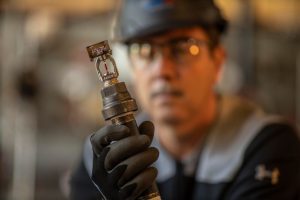When you are installing a fire sprinkler system in your facility, you want to be sure that you choose the type of system that is right for the space. Two common types of sprinkler systems include traditional wet pipe sprinklers and dry pipe fire sprinkler systems.
What is a Wet Pipe Sprinkler System?
Wet pipe fire sprinkler systems are the traditional and most common type of fire sprinkler system. In a wet pipe system, pressurized water is contained within the sprinkler pipes at all times. When the system is activated during a fire, water will be immediately discharged onto the affected area.
Advantages of Wet Pipe Systems
The biggest advantages that wet-pipe sprinkler systems offer are simplicity and reliability. Wet-pipe fire sprinkler systems contain the least number of components, reducing the risk of malfunction when the system lies dormant for long periods of time. The maintenance required to keep the system in good working condition is less than for some more complicated types of fire suppression systems. Due to the simplicity of these systems, they can be installed quickly and require less service time.
Disadvantages of Wet Fire Sprinkler Systems
The biggest disadvantage to wet pipe fire sprinkler systems is that they run the risk of freezing in temperatures below 40 degrees Fahrenheit. When sprinkler pipes freeze, the system will not work if a fire were to occur, and frozen water can cause pipes to burst and create water damage in your facility.
Common Applications for Wet Pipe Sprinklers
Some common applications where wet pipe sprinkler systems are installed include:
- Apartment buildings
- Office buildings
- Hotels
- Retail stores
- Entertainment centers
- Nursing homes
What is a Dry Pipe Fire Sprinkler System?
A dry pipe fire sprinkler system does not have water contained in the sprinkler pipes. Instead, pressurized air or nitrogen is in the sprinkler pipes and the water is held back by a dry pipe valve. When a fire is detected, the sprinkler valves open and water flows through the pipes and onto the fire.
Advantages of Dry Pipe Systems
Dry pipe sprinkler systems work well in areas that have temperatures that fall below 40⁰F since there is no water in the pipes, so they do not have the risk of freezing.
Disadvantages of Dry Fire Sprinkler Systems
Dry pipe fire sprinkler systems are typically costlier to install and maintain because it is more complex than a wet pipe fire sprinkler system. In addition, dry pipe systems may have a slightly slower response time during a fire depending on the distance between the water source and the sprinkler head. These systems are also more expensive, so it is recommended to install a wet pipe system when it is possible, but a dry pipe system may be installed as an addition to a wet pipe system to protect colder environments.
Common Applications for Dry Pipe Sprinklers
- Exposed loading docks
- Unheated warehouses
- Commercial freezers
Contact Us for Fire Sprinkler Systems
Rich Fire Protection can design, install and service fire sprinkler systems in New Jersey. Our team will take the time to educate you about the best type of sprinkler system to fit your needs. We can install both wet pipe and dry pipe fire sprinkler systems for a wide range of applications. Rich Fire provides fire protection for commercial, industrial, and residential facilities. Contact us today to learn more about our fire sprinkler services.

